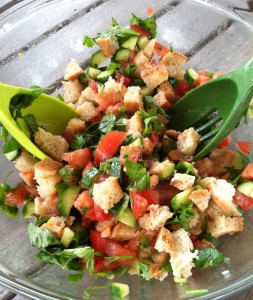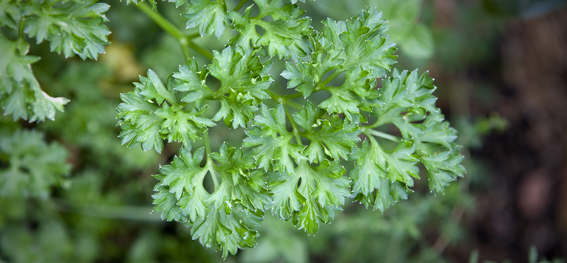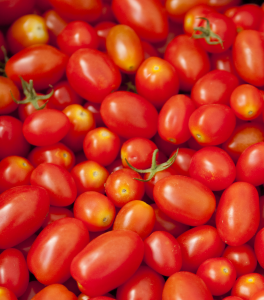Veggin’ Out in Style
Posted in Around the Garden on June 25 2013, by Sonia Uyterhoeven
Sonia Uyterhoeven is the NYBG‘s Gardener for Public Education.
 This past weekend, we were out in the Louise Loeb Vegetable Garden in the Home Gardening Center covering vegetable gardening basics. Knowing how to plant and grow vegetables is one thing, but the love and the labor means nothing if you don’t know what to do with the harvest. Bearing that in mind, I made the visitors a simple tomato and bread salad that was loaded with fresh herbs. Traditionally it is an old Tuscan recipe made from left-over (read: stale) bread. It is a quick and easy recipe that adds life to everyday meals.
This past weekend, we were out in the Louise Loeb Vegetable Garden in the Home Gardening Center covering vegetable gardening basics. Knowing how to plant and grow vegetables is one thing, but the love and the labor means nothing if you don’t know what to do with the harvest. Bearing that in mind, I made the visitors a simple tomato and bread salad that was loaded with fresh herbs. Traditionally it is an old Tuscan recipe made from left-over (read: stale) bread. It is a quick and easy recipe that adds life to everyday meals.
The ingredients for the recipe toss together the most basic herbs and vegetables from the home garden:
– 4 ripe tomatoes cut into ½-inch cubes
– 3 small Persian cucumbers cut into ½-inch cubes (or one small regular cucumber, deseeded)
– Handful of basil (approx. 2 tablespoons)
– Handful of parsley (approx. 2 tablespoons)
– Small handful of oregano (approx. 1 tablespoon)
– 4 scallions chopped into small pieces
– 1-2 garlic cloves minced (optional)
– 2 tablespoons red wine vinegar (optional: tear a few basil leaves and soak them in vinegar for a few hours overnight to give the vinegar more flavor)
– ¼ cup extra virgin olive oil
– 2 cups few-days-old Italian or French bread cut into small cubes (optional: toast the bread lightly in the oven)
– Salt and pepper to taste
I like to chop the bread into small cubes ahead of time and just cover it in a bowl and leave it to the side until I am ready to use it. I also like to add a few leaves of basil into the red wine vinegar—I add the basil into an empty mason jar and cover it with the red wine vinegar. If you choose to include garlic, chopping the garlic and letting it infuse in the vinegar for at least an hour takes some of the bite out of the fresh garlic. Remember the parsley will come in later to rescue your breath.
Combine all the ingredients together except for the bread cubes and let it infuse for half an hour. When you are ready to serve, toss in the bread and you have a refreshing summer salad that will compliment any meal. This salad is very easy to make and the only time you spend is in the chopping (which goes quickly).

You can make this recipe as simple or as complicated as you like. For a taste twist in the dressing add a teaspoon of Dijon mustard. Add cubes of your favorite cheese to it—we had it the other night paired with a blue cheese (we didn’t add to the salad but ate on the side). It was delicious. Mozzarella goes well in the salad, as do olives.
Any variations on the herbs work—if you are harvesting directly from the garden, add in thyme, chives, marjoram, or mint. If you would like to get fancy, you can deseed the tomatoes or you can roast them in the oven (add garlic while roasting) to change the texture and the flavor of the recipe. My favorite is to stick with quick and simple.
Remember to store your tomatoes at room temperature. If they are starting to get over-ripe then you should keep them in the refrigerator but use them as quickly as possible. If they have been in the fridge, chefs recommend that you take them out early before use so they return to room temperature—this should improve the flavor. Marinating them in the herbs and dressing will also add to their flavor.
A word of wisdom to gardeners: I don’t like to plant my tomatoes out too early in the season. They are a warm weather crop which really sulks if you try and start it before the nights warm up to the 50s. I amend my soil with compost and composed cow manure to create a nutrient rich soil for the tomatoes to grow. Tomatoes do not like to dry out, so keep them evenly watered—particularly when the summer heat kicks in. Even watering will also prevent blossom end rot (when the bottoms of the fruit blacken).
I plant my tomatoes deep, first removing the bottom set of leaves and burying the stem deeper into the ground. Tomatoes have the ability to root from their stem and a deep planting will encourage a good root system and a stronger stem. I also take an old piece of magazine and loosely wrap it around the base of the stem. This prevents cutworms from chewing down the tender young stems. It will rot away in no time and by then the tomato will be well-established and too tough for the cutworms.
 Staking a tomato is important to improve light and air circulation for healthy plants and the maximum amount of harvest. I like to stake tomatoes while I am planting them so that I don’t come in later and damage the root system. When I tie tomatoes to the stake, I use a figure eight configuration with the twine to avoid damaging the stem.
Staking a tomato is important to improve light and air circulation for healthy plants and the maximum amount of harvest. I like to stake tomatoes while I am planting them so that I don’t come in later and damage the root system. When I tie tomatoes to the stake, I use a figure eight configuration with the twine to avoid damaging the stem.
Pruning or training tomatoes is crucial for good production. Suckers form at the junction of the branches and the main stem. When they are small, pinch them off with your thumb and your forefinger. Remove suckers that form on the lower part of your tomato plant, as they will create weight and weaken the main stem. Removing suckers higher on the plant is optional.
Generally, if you let a tomato plant branch profusely, you will get more tomatoes but they will be smaller. I usually do more pinching and removing of suckers on large heirloom varieties that I grow for size. For cherry tomatoes, I pinch out lower suckers but let the rest do their thing. It is also a good idea to remove lower branches that lie near to the ground. Low-lying branches can be an unwelcome invitation for fungal problems and it keeps the plant neat and tidy.
The recipe above is a good reminder to plant herbs with our tomatoes. Herbs are easy to grow—most need good drainage, good sun, minimal pampering and timely harvesting before they go to flower. As the summer continues, your garden will produce plenty of lovely meals.

